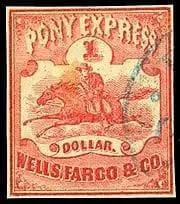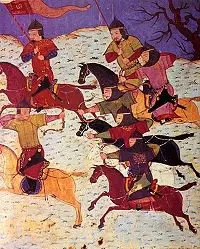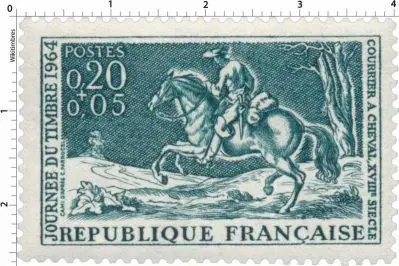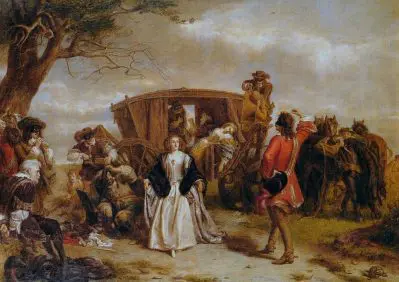Travel on Horseback
Travel on horseback and by horse-drawn vehicle has an illustrious history which has had an enormous impact on the course of world events. Today in the developed parts of the globe it has become mainly an enjoyable way for equestrians to spend a vacation, but not so long ago it was the fastest and easiest way to move from place to place. There were many advantages to horseback travel, but one of the most important was for rapid communications which are so vital for military strategy, political control and business enterprises. A famous mail delivery system of 150 years ago which has captured the popular imagination is the Pony Express carrying letters from St. Joseph, Missouri to San Francisco, a distance of about 2,000 miles, in seven days. To achieve this speed frequent relays were required. Horses would go 5 to 25 miles, depending on the terrain, and riders would often travel as far as 75 miles before passing the mail on to the next messenger. The completion of a transcontinental telegraph line soon put the Pony Express out of business, but the example of horse couriers carrying vital information stretches back over 3,000 years into history.
The ancient Persians 2,500 years ago maintained a royal road from Sardis to Susa which is nearly the same distance as the Pony Express route and, according to Herodotus, the messages routinely took about the same amount of time. Herodotus greatly admired the prowess of these Persian messengers and gave us the following quotation: “There is nothing in the world that travels faster than these Persian couriers. Neither snow nor rain nor heat nor gloom of night stays these couriers from the swift completion of their appointed rounds.” This famous quote has become a motto of the US Postal Service. The Persian Empire at the time was the largest the world had known and its management and cohesiveness was made possible by a system of horse relays which was maintained for centuries. It stretched from Egypt to Afghanistan and had many offshoots so the Sardis to Susa route was by no means the only one used for relays of horse couriers.
By contrast, during the great days of the Oregon Trail from 1846 to 1868 when about a half a million people traveled across the Rockies from the Mississippi to Oregon they had a hard covering the distance between spring and the time when the first snows made the Continental Divide impassable to Conestoga wagons.
The speed at which an army can move is a key factor in warfare. The ability to travel on horseback gave invading armies an enormous advantage. A prime example was the Mongols who, in the 13th and 14th centuries, controlled the world’s largest empire ever to exist in a single land mass. The fighting ability and ruthless tactics of the Mongols were legendary, but their incomparable speed was crucial. Mongol soldiers usually kept four horses each and changed mounts often. By using this technique they could average about 50 miles a day and keep going at this speed for weeks. Thus they could often reach their enemies and surprise them before they had word of their coming.
France, like many European countries, had a highly developed system of horse relays for travel, communications and transport of goods which got its start around 1470 when the country was beginning to recover from the devastating Hundred Years War with England. At its peak in the middle of the 19th century there were about 2,400 relay stations for its government postal service and for private or official travel. They were vital for government administration and economic development. It certainly helped to make France one of the richest and most powerful countries in the world until railways began to take over. The relay stations were usually set up about 15 miles apart because this was about the distance that a horse could cover mainly at a gallop without stopping to rest. Generally speaking a courier or other traveler could make four of these relays in a day to cover about 60 miles. They were used for stagecoaches as well as for riders. In the mid-19th century the classical French stagecoach carried sixteen people and moved day and night; only stopping to change horses and to allow the passengers to eat. Thus it took five or six days to cover the 300 miles from Paris to Lyons.
The English had similar systems and when horse travel was in its heyday in the 1830s the flying stagecoach connected the major cities going at amazing speeds. For instance, the 350 miles between London and Edinburgh could be covered in 43 hours so that the writer of a letter could have a response in four days. The relay horse stations gradually lost their importance in the mid-19th century as railway lines became more widespread though horse travel remained of vital importance for shorter distances well into the 20th century. Developments were much the same in the United States though the huge size of the country made journeys longer and more difficult.
No discussion of horse travel is complete without mentioning the highwaymen who created such romantic legends throughout Europe and America. Stagecoaches, lonely travelers and mail couriers made vulnerable targets for robbery. As legend would have it the highwaymen were a cut above the usual outlaw and quite a few were of gentle birth. There are countless fables about these colorful characters, often painted as more of a Robin Hood than a gangster, robbing from the greedy rich to give to the deserving poor. They come across as dashing, courageous and chivalrous with plenty of flair. The gripping poem, “The Highwayman”, by Alfred Noyes has an irresistible appeal. It begins…
“The wind was a torrent of darkness among the gusty trees,
The moon was a ghostly galleon tossed upon cloudy seas,
The road was a ribbon of moonlight over the purple moor,
And the highwayman came riding –
Riding – riding –
The highwayman came riding up to the old inn door.”
A striking example of horse travel transforming a society is how the acquisition of the horse after 1680 vastly improved the standard of living of the American Plains Indians. Almost overnight they were able not only to hunt the buffalo far more effectively, but also move their camps much faster to follow the migrating herds which were their main source of food, clothing and tools. They did not have wagons in the early days, but they made extensive use of pack animals and travois.
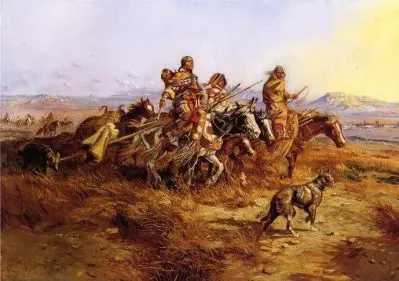 Without the tremendous empowerment of the horse, which gave such huge advantages in travel, communication, hunting, agriculture and transport, our civilization could never have reached the level it has today. Horses gave humans the opportunity to devote more time and energy to other pursuits than the constant necessity to feed themselves. It is entirely appropriate that we should still use the term horsepower today and easy to understand why horses are so interwoven with our history and culture. It is important to note also that equestrian sports and riding have been a favorite of mankind over the ages and while the economic need for horses is no longer important, the wonderful joy of riding and our bond with horses remains.
Without the tremendous empowerment of the horse, which gave such huge advantages in travel, communication, hunting, agriculture and transport, our civilization could never have reached the level it has today. Horses gave humans the opportunity to devote more time and energy to other pursuits than the constant necessity to feed themselves. It is entirely appropriate that we should still use the term horsepower today and easy to understand why horses are so interwoven with our history and culture. It is important to note also that equestrian sports and riding have been a favorite of mankind over the ages and while the economic need for horses is no longer important, the wonderful joy of riding and our bond with horses remains.
See related articles here:


